The start of the 2018 Antarctic season experienced a long period of bad weather, with atypical, heavy snowfall. Most expeditions encountered poor visibility and challenging skiing conditions for the first weeks of their journeys. This unusual weather pattern seems to be associated with strong El Niño years and it certainly brought the worst conditions we have seen in several seasons.
The trend towards more solo expeditions continued this season with ten solo expeditions starting out. The adverse conditions prevented Eric Larsen and Richard Parks from completing their attempts on the Hercules Inlet unsupported solo speed record and in total, five of this year’s soloists failed to reach the South Pole. The level of difficulty on the well-established Hercules Inlet route has not diminished with the passage of time and remains an extreme challenge, mentally and physically.
We received several inquiries from soloists interested in attempting to be the first person to complete a solo crossing of the Antarctic landmass without resupply (unsupported) and without kiting or ski-sailing (unassisted). In the end, two people had the resources and support to start, and both Colin O’Brady and Lou Rudd succeeded in completing their crossings. They both skied almost the same distance as Henry Worsley did on a different route in 2015 and about 180 miles (300 km) less than Cecilie Skog and Ryan Waters covered on their 2009 crossing – which remains the longest unsupported, unassisted journey in Antarctic history. It will be interesting to see if anyone can extend the limits of what is possible without resupply and without kiting in the next few years. There is no shortage of future challenges.
THE IMPOSSIBLE FIRST
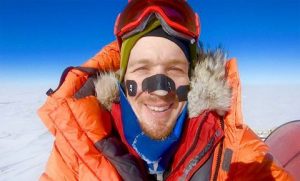 Route: Messner Start – South Pole – Leverett Glacier
Route: Messner Start – South Pole – Leverett Glacier
Skier: Colin O’Brady (USA)
Professional triathlete turned adventurer, Colin O’Brady, took on one of the most challenging objectives this season – a solo, unsupported, and unassisted transantarctic crossing. One of two men attempting this route, Colin was dropped off on November 3 at the Messner Start. From there he skied to the South Pole arriving on December 12 and continued on, reaching the base of the Leverett Glacier on the Ross Ice Shelf. He completed his crossing on December 26, covering roughly 900 statute miles (1450 km) and becoming the first person to successfully complete this objective.
Learn More:
colinobrady.com/theimpossiblefirst
SPIRIT OF ENDURANCE
Route: Messner Start – South Pole – Leverett Glacier
Skier: Lou Rudd (UK)
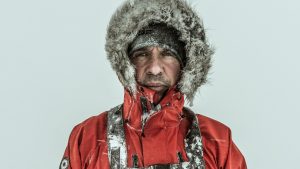
Lou Rudd is no stranger to the Antarctic having previously completed two unsupported expeditions. The first expedition was in 2011 with Henry Worsley, from the Bay of Whales to the South Pole, and the second was in 2016, as the Expedition Leader for the British Army SPEAR17 Antarctic crossing from Hercules Inlet to the base of the Shackleton Glacier on the Ross Ice Shelf. This season he took on the challenge of skiing solo, unsupported, and unassisted across Antarctica. Along with Colin O’Brady, Lou was dropped off on November 3 at the Messner Start. From there he skied to the South Pole arriving on December 13 and continued on to the base of the Leverett Glacier on the Ross Ice Shelf. He completed his crossing on December 28, becoming the second person and first Briton to successfully complete this challenge.
Learn More:
lourudd.com/spiritofendurance/
Image of Lou Rudd © Rene Koster Photography
ANTARCTICA EXTREME
 Route: Hercules Inlet – South Pole
Route: Hercules Inlet – South Pole
Skier: Danilo Callegari (Italy)
Italian adventurer, Danilo Callegari had three goals this season – ski solo, unsupported, and unassisted from Hercules Inlet to the South Pole, skydive over the Ellsworth Mountains, and summit Mount Vinson. Danilo began his South Pole expedition on November 3. He fell behind schedule after a number of bad weather days and had to decide whether to continue on to the South Pole or return to Union Glacier in order to complete his other objectives. Eventually he chose to end his South Pole attempt but went on to successfully summit Mount Vinson on December 31 and skydive over the Ellsworth Mountains.
Learn More:
danilocallegari.com/antarctica-extreme/
ALE SKI SOUTH POLE EXPEDITION – MESSNER START (AND KITE RETURN)
Route: Messner Start – South Pole – Union Glacier
Skiers: Joe Doherty (UK), Grazyna Machnik (Poland), Gábor Rakonczai (Hungary), Christian Styve (Norway, Guide)
Kiters: Joe Doherty (UK) and Christian Styve (Norway, Guide)
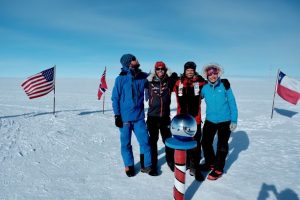
This season’s ALE Messner team consisted of three guests and ALE Guide Christian Styve. Beginning on November 24, the team skied over 500 miles (900 km) with two resupplies, to reach the South Pole on January 7.
After a few days of good meals at the ALE South Pole Camp, Christian and Joe began kiting back to Union Glacier on January 10. The two-man team traveled over 600 miles (1000 km) in 13 days, to the Plumber Glacier area. At this point, they were picked up by snowmobile and returned to Union Glacier Camp.
At 25, Joe Doherty was the youngest guided skier this season and works for the Outward Bound Trust in UK. He is a member of the Hampshire Scouts Expeditions group HSX and hoped to be a member of an HSX expedition but funding prevented more of the team from coming, so Joe joined the ALE team. Grazyna Machnik, 33, a Pole working in London as a negotiator for BP, completed her Seven Summits Challenge with an ascent of Mount Vinson after her South Pole expedition. Gábor Rakonczai, 37, became the first Hungarian to ski to the South Pole. He had previously rowed solo across the Atlantic Ocean. Christian is a Norwegian guide, logistics manager, and photographer. This was his third season working for ALE and second time guiding an ALE Ski South Pole Expedition.
Learn More:
facebook.com/antarcticlogistics
instagram.com/antarcticlogistics
twitter.com/Antarctic_ALE
ALE SKI SOUTH POLE EXPEDITION – HERCULES INLET START
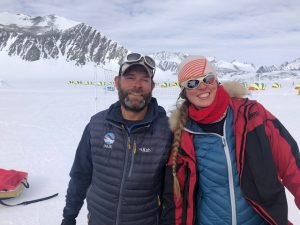
Route: Hercules Inlet – South Pole
Skiers: Sanna Kallio (Finland), Are Johansen (Norway, Guide)
ALE’s Hercules Inlet team was a small but sturdy crew this season with just one guest, Sanna Kallio, skiing alongside ALE Guide Are Johansen. The two-person team started skiing on November 24, received three resupplies along the 660+ mile (1060+ km) journey, and successfully reached the South Pole on January 7.
Sanna Kallio, 35, became the first Finnish woman to ski to the South Pole. She was very well prepared from previous experience working for the British Antarctic Survey at Halley, three years spent in Svalbard, and a crossing of the Greenland Ice Cap. Are is a Norwegian guide who guided an Antarctic out-and-back from the Ronne-Filchner Ice Shelf in 2014 and has multiple ski crossings of the Greenland Ice Cap.
Learn More:
facebook.com/antarcticlogistics
instagram.com/antarcticlogistics
twitter.com/Antarctic_ALE
OBJECTIF PÔLE SUD
Route: Hercules Inlet – South Pole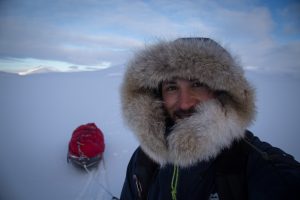
Skier: Matthieu Tordeur (France)
As the youngest member of the prestigious French Explorers Society (SEF), Matthew Tordeur has traveled to more than 90 countries. This season, he joined us in Antarctica hoping to become the first French person and youngest person to ski solo, unsupported, and unassisted from the coast of Antarctica to the South Pole. On November 24, he set out from Hercules Inlet and on January 13 he successfully arrived at the South Pole, setting two new records!
Learn More:
objectifpolesud.com
JAPANESE DRAGON TO THE SOUTH POLE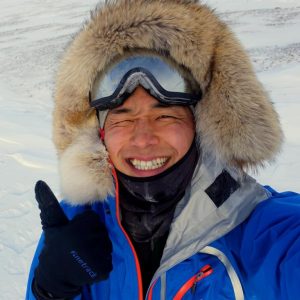
Route: Messner Start – South Pole
Skier: Masatatsu Abe (Japan)
Masatatsu began a solo, unsupported, and unassisted journey to the South Pole, from the Messner Start on November 24. While he ultimately had to take a resupply of food at Thiel Corner, his training pulling rickshaws across Japan paid off, and he successfully arrived at the South Pole on January 16, having skied over 500 miles (900 km) in 64 days.
This journey served as preparation for a much longer and more complex expedition planned for the 2019 season, when Masatatsu will attempt to follow in the footsteps of Japanese polar explorer, Nobu Shirase.
Learn More:
jinriki-support.com/abe
SP18
Route: Hercules Inlet – South Pole
Skiers: Anna Krassowska (UK), Raoul Surcouf (UK)
This two-person team set out to ski unsupported and unassisted from Hercules Inlet to the South Pole on November 24. Like many of the expeditions this year, the extreme snowfall slowed their progress, but Anna and Raoul were determined to reach their goal, no matter how long it took! On January 25, 62 days after leaving Hercules Inlet, the pair successfully arrived at the South Pole!
90° SOUTH 7TH SUMMIT
Route: Hercules Inlet – South Pole
Skier: Laval St. Germain (Canada)

Laval St. Germain is a Canadian airline pilot and adventurer who attempted to not only ski solo, unsupported, and unassisted from Hercules Inlet to the South Pole but also to climb Mount Vinson this season. Laval began his South Pole expedition on November 25. 15 days later, facing extreme weather, and falling behind schedule, Laval decided to focus on his main goal of climbing Mount Vinson and end his ski expedition. Laval summited Mount Vinson on December 31, successfully completing his seven summit attempt. Laval’s journey raised funds for the Alberta Cancer Foundation.
Learn More:
lavalstgermain.com
LAST SOUTH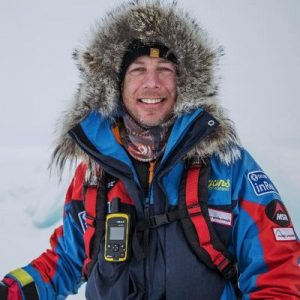
Route: Hercules Inlet – South Pole
Skier: Eric Larsen (USA)
ALE was pleased to welcome Eric Larsen back to Antarctica after a few years away. Eric has completed multiple expeditions and guided for ALE in the past, but this season he took on a speed record attempt from Hercules Inlet, in hopes of challenging Christian Eide’s incredible record of 24 days, 1 hour, and 13 minutes. Unfortunately, difficult weather slowed his progress early on and dwindling food rations forced him to end his expedition and backtrack to Thiel Corner for a pick-up, having completed over 400 miles (over 600 km) in 20 days of skiing.
Learn More:
ericlarsenexplore.com
CHALLENGE ANTARCTICA
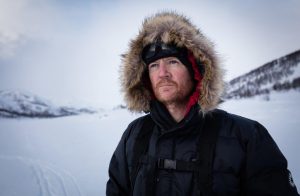 Route: Hercules Inlet – South Pole
Route: Hercules Inlet – South Pole
Skier: Baz Gray (UK)
This former British Royal Marines Commando undertook a solo, unsupported, and unassisted expedition from Hercules Inlet to the South Pole. Beginning on November 29, Baz successfully arrived at the South Pole 38 days later, an impressive accomplishment, especially given the snow conditions this season.
Baz planned this expedition as a test run for a second, longer journey planned for the 2019 season – a transantarctic crossing from Berkner Island to the Ross Ice Shelf via the South Pole.
Learn More:
satcase.com/challenge-antarctica/
SOLO TO THE SOUTH POLE
Route: Hercules Inlet – South Pole
Skier: Jenny Davis (UK)
Jenny Davis is a British lawyer and ultra-endurance athlete who attempted two Antarctic challenges this season. First, she successfully summited Mount Vinson with her fiancé on December 5. Jenny then attempted to ski solo, unsupported, and unassisted from Hercules Inlet to the South Pole. On December 12 she began skiing with goal of beating the current women’s speed record of 38 days, 23 hours, and 5 minutes, held by Johanna Davidsson. Encountering severe weather and medical issues, Jenny made the tough decision to end her expedition. She was flown back to Union Glacier on January 4.
Learn More:
jennydavis.co.uk/solo-south-pole/
TEAM QUEST
Route: Hercules Inlet – South Pole
Skier: Richard Parks (UK)
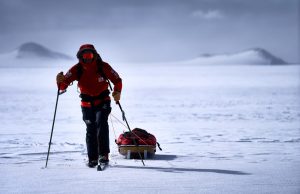 In 2014, Richard became the fastest Briton and first Welshman to ski solo, unsupported, and unassisted to the South Pole. The former rugby player turned polar adventurer returned to Antarctica this season with the same goal as Eric Larsen: breaking Christian Eide’s speed record. Like most of the other expeditions, Richard encountered extremely challenging weather conditions right from the start of his attempt. Falling behind schedule, he called an end to his expedition after 300 miles (480 km), and was picked up on January 4.
In 2014, Richard became the fastest Briton and first Welshman to ski solo, unsupported, and unassisted to the South Pole. The former rugby player turned polar adventurer returned to Antarctica this season with the same goal as Eric Larsen: breaking Christian Eide’s speed record. Like most of the other expeditions, Richard encountered extremely challenging weather conditions right from the start of his attempt. Falling behind schedule, he called an end to his expedition after 300 miles (480 km), and was picked up on January 4.
Learn More:
richardparks.co.uk
Images of Richard Parks, including banner image © Hamish Frost Photography
*ALE defines unsupported expeditions as those that start the expedition with all the equipment and supplies for the whole journey. They have no pre-placed depots, no resupplies, no support vehicles, and receive no outside help.
**ALE defines unassisted expeditions as those that are human powered and do not use external power aids for significant speed and load advantage. Assisted Antarctic expeditions typically use wind power (kites and ski-sails) or engine power (motorized vehicles).